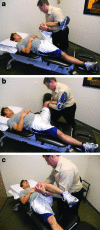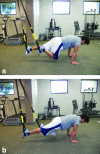Rehabilitation after hip arthroscopy and labral repair in a high school football athlete
- PMID: 22530192
- PMCID: PMC3325633
Rehabilitation after hip arthroscopy and labral repair in a high school football athlete
Abstract
Study design: Case Report
Background: Femoral acetabular impingement (FAI) has been implicated in the etiology of acetabular labral tears. The rehabilitation of younger athletes following arthroscopic surgery for FAI and labral tears is often complex and multifactorial. A paucity of evidence exists to describe the rehabilitation of younger athletes who have undergone arthroscopic hip surgery.
Case presentation: This case report describes a four-phase rehabilitation program for a high school football player who underwent hip arthroscopy with a labral repair and chondroplasty.
Outcomes: The player returned to training for football 16 weeks later and at the 4 month follow-up was pain free with no signs of FAI.
Discussion: There is little evidence regarding the rehabilitation of younger athletes who undergo arthroscopic hip surgery. This case study described a four phase rehabilitation program for a high school football player who underwent hip arthroscopy and labral repair. The patient achieved positive outcomes with a full return to athletic activity and football. The overall success of these patients depends on the appropriate surgical procedure and rehabilitation program.
Keywords: Femoral acetabular impingement (FAI), hip, hip impingement
Level of evidence: 4-Case report.
Figures
References
-
- Phillipon MSchenker ML. Arthroscopy for the treatment of femoral acetabular impingement in the athlete. Clin Sports Med. 2006; 29:299–308 - PubMed
-
- Kapron ALAnderson AEAoki SKet al. Radiographic prevalence of femoroacetabular impingement in collegiate football players. J Bone Joint Surg AM. 2011;93:e111(1–10). - PubMed
-
- Wenger DEKendell KRMiner MRet al. Acetabular labral tears rarely occur in the absence of bony abnormalities. Clin Orthop Relat Res. 2004. Sep (426):145–50 - PubMed
-
- Meermans GKonan SHaddad FSet al. Prevalence of acetabular cartilage lesions and labral tears in femoroacetabular impingement. Acta Orthop Belg. 2010. Apr;76(2):181–8 - PubMed
LinkOut - more resources
Full Text Sources
Research Materials






